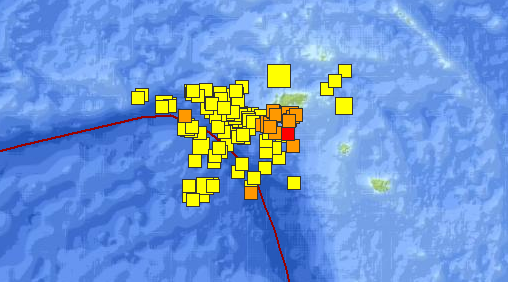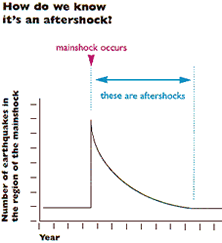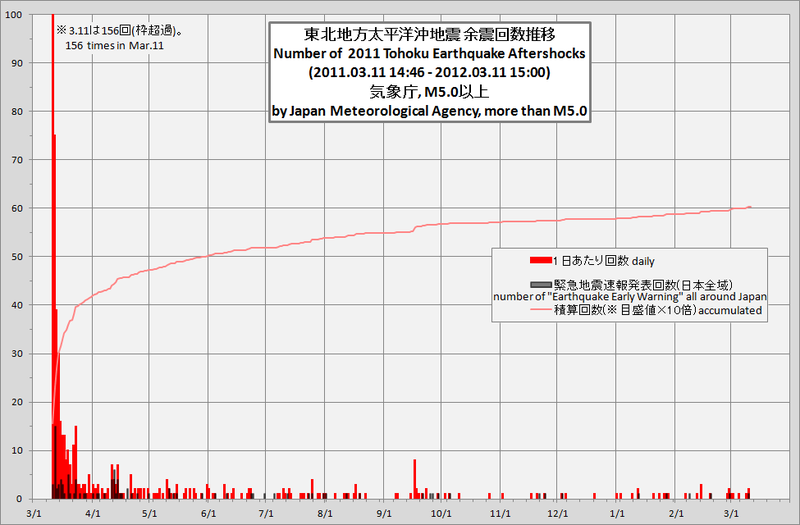
© USGSForshocks, mainshock and aftershocks in teh Solomon Islands, February 2013.
More earthquakes in the Santa Cruz Islands, in the Solomon Islands area - and they're still pretty large. Are these foreshocks, aftershocks, or what?
It's a restless Earth we live on. Certainly it must seem like that for residents of the Solomon Islands. This week they've experienced what must feel like a lifetime of earthquakes. Over a dozen quakes exceeding magnitude 5 (≥M5.0) between the first and the fifth of February could be deemed significant activity; but these were followed by a tremor of M8.0. Statistically speaking, you might expect only one or two of this magnitude in a year.
And it goes on. Earthquake after earthquake followed, and continues to follow. At the time of writing at least 80 aftershocks of ≥M5.0 have been recorded. So what are all these earthquakes and what, if anything, do they tell us?
Foreshocks, Mainshocks and AftershocksIn the sometimes-complicated language of earth science, the concept of shocks is among the easiest to understand. It's self-defining. In any sequence of earthquakes, the mainshock is the largest. Those which come before it are foreshocks and those which come after it are aftershocks - and we don't know which is the mainshock until the sequence of earthquakes is completed.
That's as simple as it gets. Earth scientists have evolved complicated laws to show that (generally speaking) there's a decrease in the size of aftershocks over time (Omori's Law) and a relationship between the size of the mainshock and the largest aftershock (Bath's Law) but even these don't always hold true. Yeats refers to 'sets ' of large earthquakes occurring in the Solomon Islands and just last year the two largest earthquakes of 2012, an M8.6 and an M8.2, occurred within hours of each other in the Indian Ocean - making the M8.2 a very large aftershock indeed.

© USGSGraph of aftershock patterns.
Again it seems self-evident that the mainshock, by definition, releases most of the accumulated strain which eventually triggers the earthquake, but not all. It is generally true that the larger the earthquake, the larger, and greater in number, the aftershocks will be (the 2011 Tohoku-Oki earthquake, an M9.0, had aftershocks of M7.9, M7.7, M7.1 and M7.0, in that order though interspersed with numerous smaller tremors).
Although most aftershocks occur relatively close to the epicentre of the mainshock and the area of the fault which has been ruptured, Liu and Stein note that aftershocks following larger earthquakes can be more widely dispersed and also that seismic waves can trigger tremors at even greater distances: these, too, should be regarded as aftershocks.
Foreshocks as Precursors of Major Tremors
© PekachuA year’s worth of aftershocks from the Tohoku-Oki earthquake of 2012.
With a pattern of foreshocks and aftershocks, you might ask whether it's possible to use foreshocks to predict a major earthquake. In his book
The Million Death Quake, seismologist Roger Musson describes an example from China in 1975 when a major earthquake was successfully predicted on the basis of foreshocks - but he goes on to describe how, the following year, a larger, much more devastating tremor in the same region occurred without any precursor. And in
Italy, seismologists who failed to treat a tremor as the precursor of a larger earthquake (which it proved to be) ended up in jail.
The problem is twofold. Firstly, as the 1976 example from China (cited above) demonstrates, not all earthquakes have foreshocks. Secondly, because a mainshock is defined as the largest earthquake in a sequence we can't know how big an earthquake to expect. So an M5.0 may be a foreshock to an M7.0 - or it may be the mainshock itself. We don't know until we have the benefit of hindsight.
Patterns of EarthquakesAlthough there are laws that can be applied to aftershocks in particular, earthquakes and their associated shocks (fore and after) remain difficult to quantify. And as long as it remains the case that earthquakes vary from location to location, along with the fact that we don't fully understand the details of where and when they occur, the use of foreshocks as even a short-term tool for predicting major earthquakes remains unproven. So, will the
7.0 and greater quakes in the Solomon Islands turn out to be foreshocks or aftershocks? Only time will tell.
Sources:
USGS.
M7.0 Santa Cruz Islands. (2013). Accessed February 8, 2013.
USGS.
Earthquake glossary. (2013). Accessed February 8, 2013.
Liu, M and Stein, S.
Earthquake Aftershocks. (2011).
Encyclopedia of Solid Earth Geophysics edited by Gupta, H. Springer. Accessed February 8, 2013.
Musson, R.
The Million Death Quake. (2012). Macmillan.
Yeats, R.
Active Faults of the World. (2012). Cambridge University Press.
Earthquake prediction is pure unadulterated BS
Anyone being paid to predict this phenomena is selling snake oil.
Scientists & science as we all know are as much in the dark as Joe Blogs
Italy has the correct concept,if ya gonna draw wages for this claptrap you better be prepared to suffer the consequences.